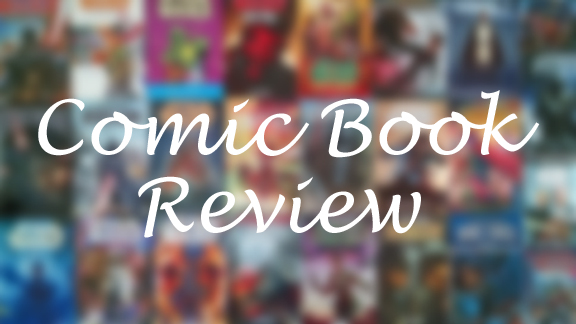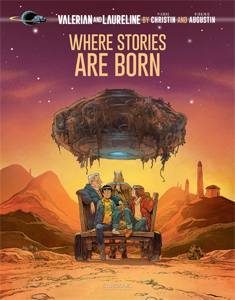In 2010, the original “Valerian and Laureline” saga ended with “The Time Opener” (Volume 21), wherein our heroes save the universe, go back in time (to what we readers know as present-day Earth), lose their memories and revert to youth. Whew.
Since then, saga creators Pierre Christin and Jean-Claude Mezieres (who died in 2022) gave a coda to the original V&L in “Memories from the Futures” (2013, Vol. 22) and tiptoed into the younger V&L’s saga in “The Future is Waiting” (2019, Vol. 23). Both are collections of short stories, with “uncle” Albert (who remembers both timelines) raising the kids in the latter case.
Now we’re off and running – so to speak — with the 56-page “Where the Stories are Born” (2022 in France, with the English translation released last month). Not that C&M were the most prolific comic-book creators ever (on average, a couple years passed between the release of each volume), but their work has been even more spaced out in the last decade.

“Valerian and Laureline: Where Stories Are Born” (2022)
Writer: Pierre Christin
Pencils and inks: Virginie Augustin
Colors: Delf and Virginie Augustin
I read all of the comics in the wake of the 2017 movie and loved being immersed. Now we’re just dipping into a new treat every few years. I’ll take what I can get, of course. “Where Stories Are Born” doesn’t include a volume number, perhaps out of respect to the late Mezieres; neither did 2017’s “Shingouzlooz, Inc.,” written and drawn by others.
Return to complexity
After the breezy volumes 22 and 23, in “Where Stories Are Born” Christin unleashes a complex, interlocking, time-jumping tale centered on resource acquisition in present day in order to save a species in the 28th century. Again, whew.
It’s amusing to see that high-school-aged Laureline has a mind-control ability, illustrated by brief blue beams from her eyes by artist and co-colorist Virginie Augustin. Valerian has no superpowers but he’s observant, providing key intel to Albert on this mission to the Caucasus Mountains even though he’s not in the loop of the specifics.
Both are headstrong, Laureline with a bit of a chip on her shoulder about the equality of women. She’s also nature-minded, quickly noting that the breaking off of glaciers high in the mountains might be due to climate change. These are the characters we know – the age reset didn’t change their natures.
I might’ve liked more cute and funny moments between the duo. As it is, they get along easily, and they gently correct their new friends (French siblings George and Salome) when they assume V&L are brother and sister.

The value of imagination
Still, “Where Stories Are Born” is generally a playful entry, as Christin comments on the value of imaginative stories for keeping people happy in the 28th century. The Delphs are a robotic species that tells stories but have run low on originality due to a shortage of the “exceedingly rare substance” found in the 21st century Caucasus Mountains. People of the 28th century aimlessly wander the corridors of Galaxity, most not even mesmerized by their handheld entertainment devices anymore.
Both Mistress Na Zultra (“The Circles of Power”), of Rubanis in the 28th century, and Ms. Richbough, of Silicon Valley in the 21st century, are powerful women who mistreat their assistants — a Schniarfor “living weapon” in the former case, a himbo surfer dude in the latter. One of the surfer’s duties is “comfort sex partner” — not that he’s complaining much.
Christian was ahead of his time in 1967 in making Laureline equal to Valerian, while also having them exist in societies that leaned sexist. So although the power-grubbing villains of “Where Stories Are Born” are female, longtime readers will know this continues that tradition of equality along gender lines – even among villains — rather than being an anti-woman statement.
I’m slightly hesitant about the notion of Laureline having that superpower, but “V&L” has long since established itself as an “anything goes” saga. Whatever Christin dreams up, it’s fun, funny or a commentary on society (or all three). Storytelling shortcuts (another example being the Transmuter’s ability to copy money, thus providing a supply whenever it’s needed) have never trivialized the plots. So I’ll give Super-Laureline a chance.
Augustin ably takes over
No one can replace Mezieres, but it’s hard to imagine a better artist to take the baton than Augustin. She comes in at a good time, not having to draw adult V&L. The child versions look right, and her versions of familiar characters – from Albert to the Schniarfor – are excellent.
There’s slightly less background detail than what Mezieres would do, but then again, most of this story takes place on plain ole modern-day Earth. She shows humorous creature-creation skills in a montage of the Delphs’ commercially successful interspecies love stories.
Valerian and Laureline are in good – if slow-working – hands. We might have to wait a few years between volumes, but I wouldn’t want to rush the creators.
Click here for a complete index of “Valerian and Laureline” reviews.

